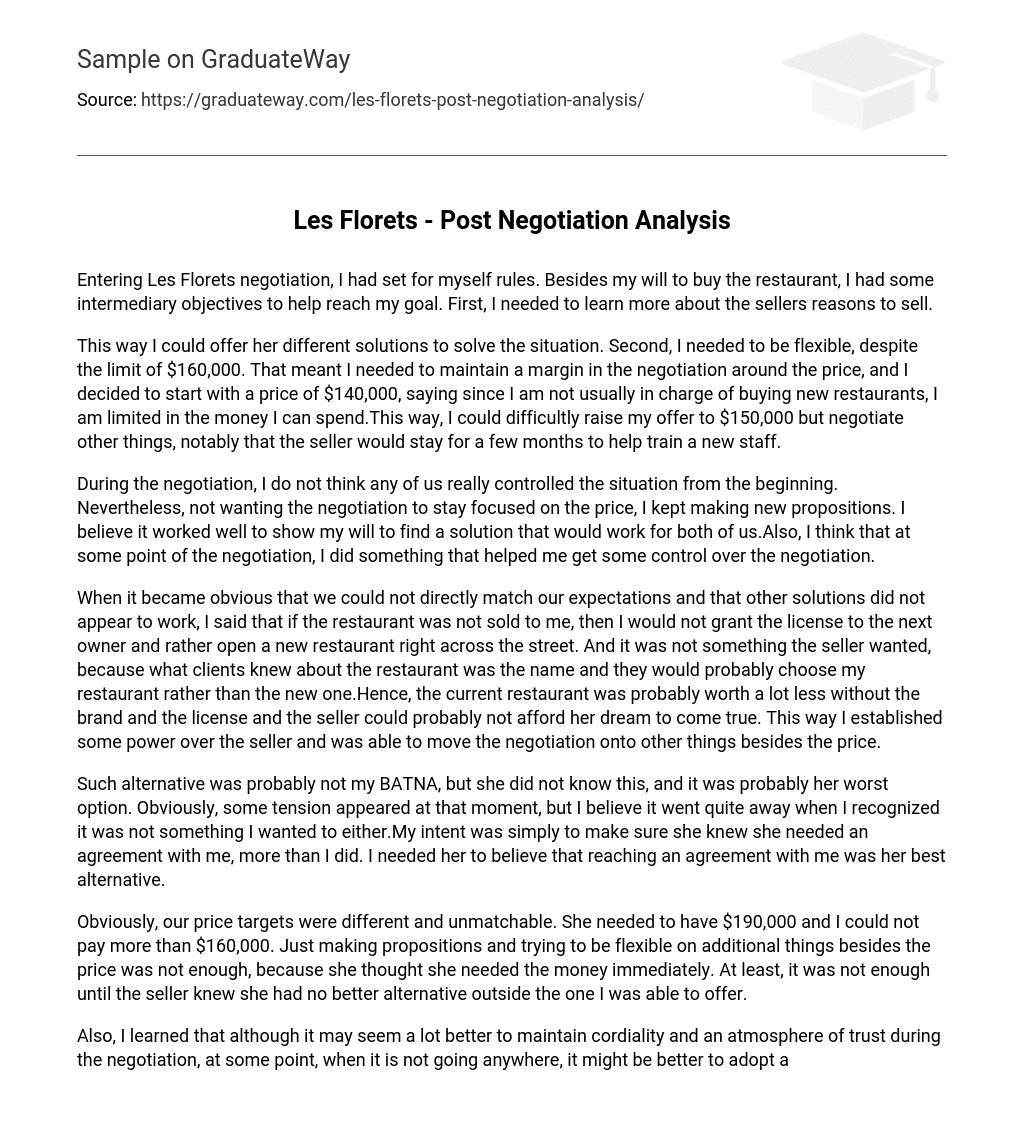Entering Les Florets negotiation, I had set for myself rules. Besides my will to buy the restaurant, I had some intermediary objectives to help reach my goal. First, I needed to learn more about the sellers reasons to sell.
This way I could offer her different solutions to solve the situation. Second, I needed to be flexible, despite the limit of $160,000. That meant I needed to maintain a margin in the negotiation around the price, and I decided to start with a price of $140,000, saying since I am not usually in charge of buying new restaurants, I am limited in the money I can spend.This way, I could difficultly raise my offer to $150,000 but negotiate other things, notably that the seller would stay for a few months to help train a new staff.
During the negotiation, I do not think any of us really controlled the situation from the beginning. Nevertheless, not wanting the negotiation to stay focused on the price, I kept making new propositions. I believe it worked well to show my will to find a solution that would work for both of us.Also, I think that at some point of the negotiation, I did something that helped me get some control over the negotiation.
When it became obvious that we could not directly match our expectations and that other solutions did not appear to work, I said that if the restaurant was not sold to me, then I would not grant the license to the next owner and rather open a new restaurant right across the street. And it was not something the seller wanted, because what clients knew about the restaurant was the name and they would probably choose my restaurant rather than the new one.Hence, the current restaurant was probably worth a lot less without the brand and the license and the seller could probably not afford her dream to come true. This way I established some power over the seller and was able to move the negotiation onto other things besides the price.
Such alternative was probably not my BATNA, but she did not know this, and it was probably her worst option. Obviously, some tension appeared at that moment, but I believe it went quite away when I recognized it was not something I wanted to either.My intent was simply to make sure she knew she needed an agreement with me, more than I did. I needed her to believe that reaching an agreement with me was her best alternative.
Obviously, our price targets were different and unmatchable. She needed to have $190,000 and I could not pay more than $160,000. Just making propositions and trying to be flexible on additional things besides the price was not enough, because she thought she needed the money immediately. At least, it was not enough until the seller knew she had no better alternative outside the one I was able to offer.
Also, I learned that although it may seem a lot better to maintain cordiality and an atmosphere of trust during the negotiation, at some point, when it is not going anywhere, it might be better to adopt a stronger position. Mainly, it had to be used to show the other party that even if an agreement is profitable for both parties, there is a point of no return, that it is time to really start looking for other solutions, more creative ones. After having established my position over the seller, making new propositions was a lot easier.Also, she had realized that not reaching an agreement with me meant that she could not pursue her lifes dream, whereas reaching an agreement with me made it possible for even if it meant having to delay for a few months.
Adopting a stronger position and showing her her worst alternative did work, it seems to me. But it also worked because I made a point at not threatening her, just point out the obvious and recognize it not what I wanted anyway, and maintain some trust afterwards. That is definitely something I will want to reproduce.





